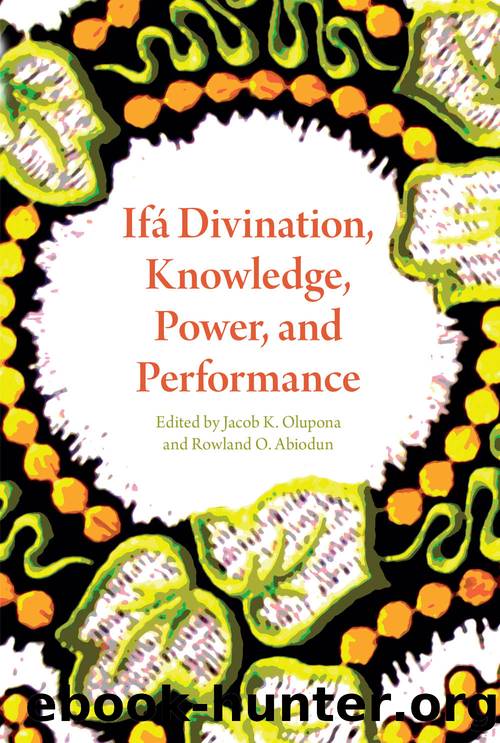Ifá Divination, Knowledge, Power, and Performance by Jacob K. Olupona & Rowland O. Abiodun

Author:Jacob K. Olupona & Rowland O. Abiodun
Language: eng
Format: epub
Publisher: Indiana University Press
Published: 2016-09-15T00:00:00+00:00
Altars: Art, Icons, and Symbols
In the above case study, Beverly mentions setting up altars and establishing connection with her ancestors as very significant aspects of her life. What problematic cultural or psychological situation has been addressed? For Beverly, it was a feeling of alienation, fragmentation, and disconnection. Perhaps for this reason, establishing an altar for oneâs ancestors is considered very important in the Orisha traditions. Such rituals of remembrance are integral to the African cosmology and indicate the cultural value placed on the âbirth, death, rebirthâ life cycle. Death is considered a moment of transition from one form to another, material to spirit, from embodied to disembodied existence. Orisha traditions teach that ancestral spirits can be accessed and engaged as support in the vicissitudes of life. Beverly established a basic ancestral altar, which included one or more glasses of water, a white candle, pictures of her deceased mother and father, a Bible, and sometimes fresh-cut flowers, all attractively arranged on a shelf covered with a white cloth. She prays in front of the altar and seeks guidance from the spirits of her ancestors. One of her deceased relatives often appears in her dreams. Her godfather has told her not to be afraid of shadows or feeling a presence in her room, for accepting and understanding this phenomenon is a part of her spiritual development. Thus the ancestral altar is a critical part of Beverlyâs reconstruction of self.
In addition to ancestral altars, Orisha practitioners also establish altars for their most important deities, particularly their guardian orisha, the one who is said to rule the head, the center of spiritual life. In one of her readings, Beverlyâs godfather told her that she was a child of Oshun and should find ways to engage the energy of Oshun. After several informal conversations, Beverly learned that âOshun is creativity, sensuality, sexuality, joy, and love. Her number is five; her symbols include the peacock, the catfish, the pineapple, as well as combs, mirrors, and brass bangles; her colors are yellow and orange.â4 Using items from this list, Beverly erected an altar to Oshun and included more âOshun colorsâ in her wardrobe as well as her home decor. In these ways she began to embody the Orisha traditions, reflecting not only a new understanding of self but also a new expression of the energy matrix called Oshun. Thus not only has Beverly changed, but so has the Oshun text. And what we see here is an integration of myth and ritual, signs and symbols in aspects of personal development as well as in the transmission of culture and the expansion of social knowledge.
In explaining this phenomenon, Clyde Ford suggests that the orisha should be viewed as âpersonifications of those archetypal energies that manifest in nature and within human life. . . . The individual, through ritual address, possesses the gods and goddesses as a way of repossessing those essential, divine aspects of oneâs selfâ (1999, 145). Soyinka refers to these archetypal energies of the Yorùbá pantheon as âessence-ideals,â reflecting the self.
Download
This site does not store any files on its server. We only index and link to content provided by other sites. Please contact the content providers to delete copyright contents if any and email us, we'll remove relevant links or contents immediately.
The Four Agreements by Don Miguel Ruiz(6552)
Breaking Free by Rachel Jeffs(4121)
The Hatha Yoga Pradipika (Translated) by Svatmarama(3189)
120 Days of Sodom by Marquis de Sade(3125)
Member of the Family by Dianne Lake(2284)
The Tao of Physics by Fritjof Capra(2209)
The Psychedelic Gospels: The Secret History of Hallucinogens in Christianity by Jerry B. Brown(2097)
The Road to Jonestown by Jeff Guinn(2002)
Going Clear: Scientology, Hollywood, and the Prison of Belief by Lawrence Wright(1912)
Going Clear by Lawrence Wright(1897)
Uriel's Machine by Christopher Knight(1846)
The Grand Grimoire: The Red Dragon by Author Unknown(1739)
The Gnostic Gospel of St. Thomas by Tau Malachi(1715)
Key to the Sacred Pattern: The Untold Story of Rennes-le-Chateau by Henry Lincoln(1577)
The Malloreon: Book 02 - King of the Murgos by David Eddings(1536)
Waco by David Thibodeau & Leon Whiteson & Aviva Layton(1511)
The New World Order Book by Nick Redfern(1509)
The Secret of the Temple by John Michael Greer(1446)
Animal Speak by Ted Andrews(1428)
